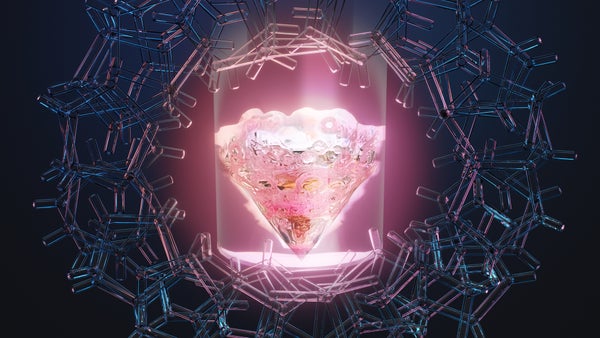Chemists Finally Made a Compound Containing Mysterious Element Promethium
Promethium, one of the rarest and most mysterious elements in the periodic table, has finally given up some crucial chemical secrets

Promethium is a rare earth element, shown here in this conceptual art in a vial surrounded by an organic ligand.
Jacquelyn DeMink (art); Thomas Dyke, (photography); ORNL, U.S. Dept. of Energy
One of the rarest and most mysterious elements in the periodic table has finally given up some crucial chemical secrets, eight decades after its discovery. Researchers at Oak Ridge National Laboratory in Tennessee have become the first to use radioactive promethium to make a chemical ‘complex’ — a compound in which it is bound to a few surrounding molecules. This feat of synthesis enabled the team to study how the element bonds with other atoms in a solution with water. Published May 22 in Nature the findings fill a long-standing gap in chemistry textbooks, and could eventually lead to better methods for separating promethium from similar elements in nuclear waste, for example.
“It’s a tour de force,” says Polly Arnold, a chemist at Lawrence Berkeley National Laboratory in Berkeley, California, who was not involved in the research.
Promethium is the most elusive member of the lanthanide family, a row of 15 metals marooned in the periodic table’s southern territories. Discovered in 1945, the element was named after the Titan who stole fire from the gods in Greek mythology. Researchers estimate that less than 1 kilogram of it currently exists naturally in the Earth’s crust, and its radiation has previously been harnessed to power pacemakers and spacecraft.
On supporting science journalism
If you’re enjoying this article, consider supporting our award-winning journalism by subscribing. By purchasing a subscription you are helping to ensure the future of impactful stories about the discoveries and ideas shaping our world today.
Together with a couple of other metals, the lanthanides are collectively known as rare-earth elements, and many are prized for their uses in technology, including lasers and powerful magnets. Although many rare-earth elements are — counter-intuitively — abundant in Earth’s crust, they are thinly spread and can be difficult to isolate. That’s partly because they share remarkably similar chemistry, which makes it challenging to extract just one lanthanide element and isolate it from the rest.
Current separation methods often use molecules known as ligands to bind to positively charged lanthanide ions in solution, forming coordination complexes. Chemists can then exploit subtle differences between these complexes to separate them: for example, by selectively washing the complexes out of water using organic solvents. “But you need lots and lots of repeated separations to get to the pure material,” says Oak Ridge chemist Ilja Popovs, who co-led the research.
Promethium has been something of a closed book for researchers working on improved separation methods. Chemists have succeeded at making only a handful of promethium compounds, all of them simple solids such an oxide3 — but never a complex that shows how promethium might bond to separation ligands in solution.
Promethium surrounded
The Oak Ridge researchers have filled that gap using promethium-147, a radioactive isotope with a half-life of about 2.5 years, which they harvested from waste generated during the production of radioactive plutonium. Like all the other lanthanides, promethium tends to form ions with a triple positive charge.
The team combined these ions with a ligand called bispyrrolidine diglycolamide, which contains three electron-rich oxygen atoms. Three of these ligands hugged each promethium ion, generating complexes with nine promethium–oxygen bonds.
Using X-ray absorption spectroscopy and theoretical simulations, the researchers measured the average length of these bonds. They also found that oxygen forms the bonds by providing pairs of electrons that neatly fill empty energy levels, known as orbitals, around promethium.
“It’s just incredibly difficult, skilful work, and it’s really impressive that they’ve been able to do it,” says Arnold, who studies lanthanides and their heavier cousins, the actinide elements.
Completing the set
Finally, to see how their promethium complex stacked up against other lanthanide complexes, the Oak Ridge researchers combined the same ligand with all the other lanthanides. This produced the first complete collection of comparable lanthanide complexes in solution, and revealed how the length of the lanthanide–oxygen bond decreases, from left to right, across the lanthanide series in the periodic table — a consequence of a well-known effect called the lanthanide contraction.
With every step along the lanthanide series, from lanthanum to lutetium, each element gains one proton and one electron. Protons add to an atom’s nucleus, while electrons add to its orbitals. With lanthanides, the electrons gradually fill up a particular set of electron orbitals known as 4f that are rather diffuse and therefore do not ‘shield’ the other negatively charged electrons in an atom from the growing positive charge of its nucleus. This allows the nucleus to exert a stronger pull on some orbitals, and contract the atom more than otherwise expected.Because the ligands in their lanthanide complexes donate electrons to the orbitals of the central ions, the Oak Ridge researchers were able to see this lanthanide contraction in the bond lengths across their newly synthesized collection. They also observed that the decrease in bond length in the earlier part of the series, from lanthanum to promethium, was sharper than in the later part of the series. Although these results are not especially surprising, says Alexander Ivanov, a chemist at Oak Ridge who co-led the work, “it was exciting to confirm that this lanthanide contraction also exists in solution.”
This article is reproduced with permission and was first published on May 22, 2024.
